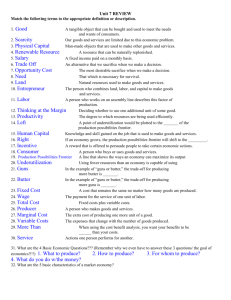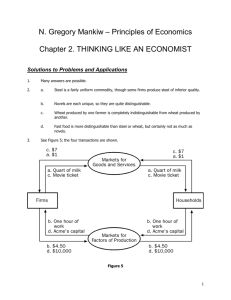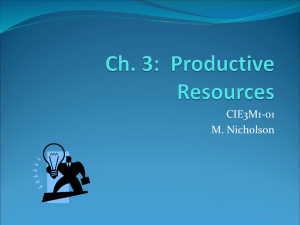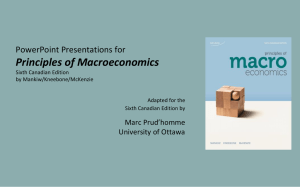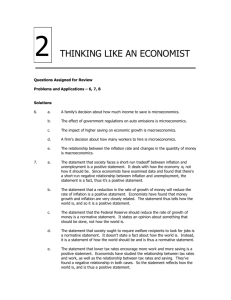Thinking Like an Economist
advertisement
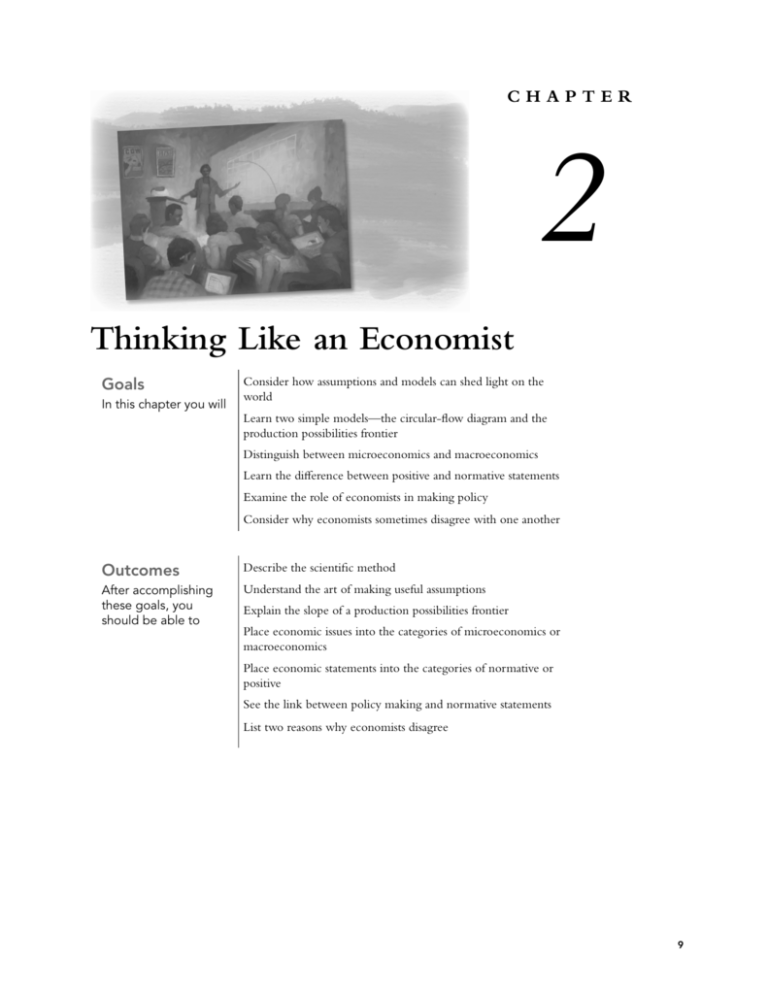
CHAPTER 2 Thinking Like an Economist Goals in this chapter you will Consider how assumptions and models can shed light on the world Learn two simple models—the circular-flow diagram and the production possibilities frontier Distinguish between microeconomics and macroeconomics Learn the difference between positive and normative statements Examine the role of economists in making policy Consider why economists sometimes disagree with one another Outcomes Describe the scientific method after accomplishing these goals, you should be able to Understand the art of making useful assumptions Explain the slope of a production possibilities frontier Place economic issues into the categories of microeconomics or macroeconomics Place economic statements into the categories of normative or positive See the link between policy making and normative statements List two reasons why economists disagree 9 10 Chapter 2 Thinking Like an Economist Strive for a Five The material in Chapter 2 falls under the basic economic concepts for both the microand macroeconomics AP tests. Specifically, it covers ■■ The circular-flow model ■■ The production possibilities frontier/curve Chapter Overview Context and Purpose Chapter 2 is the second chapter in a three-chapter section that serves as the introduction of the text. Chapter 1 introduced ten principles of economics that will be revisited throughout the text. Chapter 2 develops how economists approach problems, while Chapter 3 will explain how individuals and countries gain from trade. The purpose of Chapter 2 is to familiarize you with how economists approach economic problems. With practice, you will learn how to approach similar problems in this dispassionate, systematic way.You will see how economists employ the scientific method, the role of assumptions in model building, and the application of two specific economic models.You will also learn the important distinction between two roles economists can play: as scientists when we try to explain the economic world, and as policymakers when we try to improve it. Chapter Review Introduction Like other fields of study, economics has its own jargon and way of thinking. It is necessary to learn the special language of economics, because knowledge of the economic vocabulary will help you communicate with precision to others about economic issues. This chapter will also provide an overview of how economists look at the world. The Economist as Scientist Although economists don’t use test tubes or telescopes, they are scientists because they employ the scientific method—the dispassionate and objective development and testing of theories. ■■ The Scientific Method: Observation, Theory, and More Observation Just as in other sciences, an economist observes an event, develops a theory, and collects data to test the theory. An economist observes inflation, creates a theory that excessive growth in money causes inflation, and then collects data on money growth and inflation to see if there is a relationship. Collecting data to test economic theories is difficult, however, because economists usually cannot create data from experiments. That is, economists cannot manipulate the economy just to test a theory. Therefore, economists often use data gathered from historical economic events. ■■ The Role of Assumptions Assumptions are made to make the world easier to understand. A physi­cist assumes an object is falling in a vacuum when measuring acceleration due to gravity. This as­sumption is reasonably accurate for a marble but not for a beach ball. An economist may assume that prices are fixed (can’t be changed) or may assume that prices are flexible (can move up or down in response to market pressures). Because prices often cannot be changed quickly (the menu in a restau­ rant is expensive to change) but can be changed easily over time, it is reasonable for economists to assume that prices are fixed in the short run but flexible in the long run. The art of scientific thinking is deciding which assumptions to make. ■■ Economic Models Biology teachers employ plastic models of the human body. They are simpler than the actual human body but that is what makes them useful. Economists use economic models that are composed of diagrams and equations. Economic models are based on assumptions and are simplifications of economic reality. ■■ Our First Model: The Circular-Flow Diagram The circular-flow diagram shows the flow of goods and services, factors of production, and monetary payments Chapter 2 Thinking Like an Economist ■■ between households and firms. Households sell the factors of production, such as land, labor, and capital to firms, in the market for factors of pro­duction. In exchange, the households receive wages, rent, and profit. Households use these dollars to buy goods and services from firms in the market for goods and services. The firms use this revenue to pay for the factors of production, and so on. This is a simplified model of the entire economy. This version of the circular-flow diagram has been simplified because it excludes international trade and the government. Our Second Model: The Production Possibilities Frontier A production possibilities frontier is a graph that shows the combinations of output the economy can possibly produce given the available factors of production and the available production technology. It is drawn assuming the economy produces only two goods. This model demonstrates the following economic principles: ■■ If the economy is operating on the production possibilities frontier, it is operating efficiently be­cause it is producing a mix of output that is the maximum possible from the resources available. ■■ Points inside the curve are, therefore, inefficient. Points outside the curve are currently unattainable. If the economy is operating on the production possibilities frontier, we can see the trade-offs so­ciety faces. To produce more of one good, it must produce less of the other. The amount of one good given up when producing more of another good is the opportunity cost of the additional production. ■■ The production possibilities frontier is bowed outward because the opportunity cost of produc­ing more of a good increases as we near maximum production of that good. This is because we use resources better suited toward production of the other good in order to continue to expand production of the first good. ■■ A technological advance in production shifts the production possibilities frontier outward. This is a demonstration of economic growth. Microeconomics and Macroeconomics Economics is studied on various levels. Microeconomics is the study of how households and firms make decisions and how they interact in specific markets. Macroeconomics is the study of economywide phenomena such as the federal deficit, the rate of unemployment, and policies to improve our standard of living. Microeconomics and macroeconom­ics are related because changes in the overall economy arise from decisions of millions of individuals. Although related, the methods employed in microeconomics and macroeconomics differ enough that they are often taught in separate courses. ■■ ■■ The Economist as Policy Adviser When economists attempt to explain the world as it is, they act as scientists. When economists at­tempt to improve the world, they act as policy advisers. Correspondingly, positive statements de­scribe the world as it is, while normative statements prescribe how the world ought to be. Positive statements can be confirmed or refuted with evidence. Normative statements involve values (ethics, religion, political philosophy) as well as facts. For example, “Money growth causes inflation” is a positive statement (of a scientist). “The govern­ment ought to reduce inflation” is a normative statement (of a policy adviser). The two statements are related because evidence about whether money causes inflation might help us decide what tool the government should use if it chooses to reduce inflation. Economists act as policy advisers to the government in many different areas. The president is advised by economists on the Council of Economic Advisers, the Department of the Treasury, the Department of Labor, and the Department of Justice. Congress is advised by economists from the Congressional Budget Office and the Federal Reserve. Why Economists Disagree There are two reasons why economists have a reputation for giving conflicting advice to policymakers. ■■ Economists may have different scientific judgments. That is, economists may disagree about the validity of alternative positive theories regarding how the world works. For 11 12 Chapter 2 Thinking Like an Economist ■■ example, economists differ in their views of the sensitivity of household saving to changes in the after-tax return to saving. Economists may have different values. That is, economists may have different normative views about what policy should try to accomplish. For example, economists differ in their views of whether taxes should be used to redistribute income. In reality, although there are legitimate disagreements among economists on many issues, there is tremendous agreement on many basic principles of economics. Let’s Get Going In the next chapter, we will begin to apply the ideas and methods of economics. As you begin to think like an economist, you will use a variety of skills—mathematics, history, politics, philosophy—with the objectivity of a scientist. Helpful Hints 1. Opportunity costs are usually not constant along a production pos­sibilities frontier. Notice that the production possibilities frontier shown in Exhibit 1 is bowed out­ward. It shows the production trade-offs for an economy that pro­duces only paper and pencils. If we start at the point where the economy is using all of its re­sources to produce paper, pro­ducing 100 units of pencils only requires a trade-off or an opportu­nity cost of 25 units of paper (point A to point B). This is because when we move resources from paper to pencil production, we first move those resources best suited for pen­cil production and poorly suited for paper production. Therefore, pencil production increases with very little decrease in paper production. However, if the economy were operating at point C, the opportunity cost of an additional 100 pencils (point C to D) is 200 units of paper. This is because we now move resources toward pencil production that were extremely well suited for paper production and are poorly suited for pencil produc­tion. Therefore, as we produce more and more of any particular good, the opportunity cost per unit tends to rise because resources are specialized. That is, resources are not equally well suited for producing each output. The argument here applies when moving either direction on the production possibilities frontier. For example, if we start at point D (maximum production of pencils), a small reduction in pencil production (100 units) releases enough resources to increase production of paper by a large amount (200 units). However, moving from point B to point A only increases paper produc­tion by 25 units. 2. A production possibilities frontier only shows the choices available—not which point of produc­tion is best. A common mistake made by students when using production possibilities frontiers is to look at a production possibilities frontier and suggest that a point somewhere near the middle “looks best.” Students make this subjective judgment because the middle point appears to pro­vide the biggest total number of units of production of the two goods. However, ask yourself the following question. Using the production possibilities frontier in Exhibit 1, what production point would be best if paper were worth $10 per sheet and pencils were worth 1 cent per dozen? We would move our resources toward paper production. What if paper were worth 1 cent per sheet and pencils were worth $50 each? We would move our resources toward pencil produc­tion. Clearly, what we actually choose to produce depends on the price of each good. Therefore, a production possibilities frontier only provides the choices available; it alone cannot determine which choice is best. 3. Economic disagreement is interesting but economic consensus is more important. Economists have a reputation for disagreeing with one another because we tend to highlight our differences. While our disagreements are interesting to us, the matters on which we agree are more impor­tant to you. There are a great number of economic principles for which there is near unanimous support within the economics profession. The aim of this text is to concentrate on the areas of agreement within the profession as opposed to the areas of disagreement. Chapter 2 1 Paper EXHIBIT A 500 thinking like an eConomist B 400 300 C 200 100 D 0 100 200 300 400 500 600 Pencils Self-Test Multiple-Choice Questions 1. In the simple circular-flow diagram, the participants in the economy are a. firms and government. b. households and firms. c. households and government. d. households, firms, and government. e. firms and government. 2. In the circular-flow diagram, which of the following is not a factor of production? a. labor b. land c. capital d. money e. entrepreneurship Figure 2-1 3. Refer to Figure 2-1. If Box C in this diagram represents the markets for goods and services, boxes A and B of this circular-flow diagram represent a. firms and households. b. households and government. c. the markets for goods and services and the markets for financial assets. d. the markets for goods and the markets for services. e. the market for factors of production. 13 14 Chapter 2 Thinking Like an Economist 4. Unemployment would cause an economy to a. b. c. d. e. produce inside its production possibilities frontier. produce on its production possibilities frontier. produce outside its production possibilities frontier. experience an inward shift of its production possibilities frontier. experience an outward shift of its production possibilities frontier. 5. Production possibilities frontiers are usually bowed outward. This is because a. the more resources a society uses to produce one good, the fewer resources it has available to produce another good. b. it reflects the fact that the opportunity cost of producing a good decreases as more and more of that good is produced. c. of the effects of technological change. d. resources are specialized; that is, some are better at producing particular goods rather than other goods. e. of the diminishing marginal utility associated with increased amounts of a good. 6. The following table contains some production possibilities for an economy for a given year. Cars 10 12 14 Newspapers 400 360 ? If the production possibilities frontier is bowed outward, then “?” could be a. 370. b. 340. c. 330. d. 320. e. 310. Figure 2-2 J K L M N 7. Refer to Figure 2-2. This economy has the ability to produce at which point(s)? a. b. c. d. e. J, K, M, N K, M, N K, N M J, K, L, N Chapter 2 Thinking Like an Economist Toasters Figure 2-3 35 C 30 25 A 20 15 B D 10 5 10 20 30 40 50 60 70 Toothbrushes 8. Refer to Figure 2-3. The opportunity cost of this economy moving from point A to point B is a. zero toasters. b. ten toasters. c. ten toothbrushes. d. twenty toasters. e. twenty toothbrushes. Toasters Figure 2-4 35 C 30 25 A 20 15 D 10 B 5 10 20 30 40 50 60 70 Toothbrushes 9. Refer to Figure 2-4. Which of the following events would explain the shift of the production possibilities frontier from A to B? a. The economy’s citizens developed an enhanced taste for batteries. b. The economy experienced a technological advance in the production of batteries. c. The economy experienced an overall technological advance in all areas of production. d. More capital became available in the economy. e. More labor became available in the economy. 15 16 Chapter 2 Thinking Like an Economist 10. A production possibilities frontier shifts outward when a. the economy experiences economic growth. b. the desires of the economyís citizens change. c. the economy abandons inefficient production methods in favor of efficient production methods. d. opportunity costs are lessened. e. government increases the amount of money in the economy. 11. One way to characterize the difference between positive statements and normative statements is as follows: a. Positive statements tend to reflect optimism about the economy and its future, whereas normative statements tend to reflect pessimism about the economy and its future. b. Positive statements offer descriptions of the way things are, whereas normative statements offer opinions on how things ought to be. c. Positive statements involve advice on policy matters, whereas normative statements are supported by scientific theory and observation. d. Economists outside of government tend to make normative statements, whereas government-employed economists tend to make positive statements. e. Microeconomists make positive statements, whereas macroeconomists make normative statements. 12. Suppose an economy produces two goods, food and machines. This economy always operates on its production possibilities frontier. Last year, it produced fifty units of food and thirty machines. This year, it experienced a technological advance in its machinemaking industry. As a result, this year the society wants to produce fifty-five units of food and thirty machines. Which of the following statements is correct? a. Because the technological advance occurred in the machine-making industry, it will not be possible to increase food production without reducing machine production to less than thirty. b. Because the technological advance occurred in the machine-making industry, increases in output can only occur in the machine industry. c. In order to increase food production in these circumstances without reducing machine production, the economy must reduce inefficiencies. d. The technological advance reduced the amount of resources needed to produce thirty machines, so these resources could be used to produce more food. e. In order to produce the fifty-five units of food and thirty machines, the economy would have to reduce its level of unemployment. Free Response Questions 1. Using the following outline, draw a circular-flow diagram representing the interactions between households and firms in a simple economy, assuming that the market for goods and services is in the top box and firms are in the box to the left. Explain briefly the various parts of the diagram. 2. Draw a production possibilities frontier showing increasing opportunity cost of hammers in terms of horseshoes. a. On the graph, identify the area of feasible outcomes and the area of infeasible outcomes. b. On the graph, label a point that is efficient and a point that is inefficient. c. On the graph, illustrate the effect of the discovery of a new vein of iron ore, a resource needed to make both horseshoes and hammers, on this economy. d. On a second graph, illustrate the effect of a new computerized assembly line in the production of hammers on this economy. Chapter 2 Thinking Like an Economist Solutions Multiple-Choice Questions 1. b TOP: Circular-flow diagram 2. d TOP: Circular-flow diagram/Factors of production 3. a TOP: Circular-flow diagram 4. a TOP: Production possibilities frontier/ Unemployment 5. d TOP: Production possibilities frontier 6. e TOP: Production possibilities frontier 7. b TOP: Production possibilities frontier 8. b TOP: Production possibilities frontier/Opportunity cost 9. b TOP: Production possibilities frontier 10. a TOP: Production possibilities frontier/ Economic growth 11. b TOP: Positive statements/ Normative statements 12. d TOP: Production possibilities frontier Free Response Questions 1. Revenue MARKETS FOR GOODS AND SERVICES •F irms sell •Households buy Goods and services sold FIRMS • Produce and sell goods and services • Hire and use factors of production Inputs for production Wages, rent, and profit Spending Goods and services bought HOUSEHOLDS •Buy and consume goods and services •Own and sell factors of production Labor, land, and capital MARKETS FOR FACTORS OF PRODUCTION •Households sell Income •F irms buy = Flow of inputs & outputs = Flow of dollars This diagram should duplicate the essential characteristics of the diagram in the text, with an explanation of the meaning of each flow and each market. It is important that the student understands that the inner loop represents the flow of real goods and services and that the outer loop represents the corresponding flow of payments. TOP: Circular-flow diagram 17 18 Chapter 2 Thinking Like an Economist 2. A.Any point on (or under) a production possibility curve is feasible. Any point outside of a production possibility curve is infeasible. B. Any point on the production possibility curve is efficient, and any point under the curve is inefficient. C.The discovery of new resources that would increase the ability to produce both goods would shift the entire production possibility curve outward. D. The discovery of a technology that would only effect only the production of hammers would shift the production possibilities curve outward on the hammers axis but have no effect on the production possibilities of horseshoes. See graphs below Hammers Infeasible efficient discovery Feasible inefficeint Horseshoes (a-c) Hammers Horseshoes (d) TOP: Production possibilities frontier


